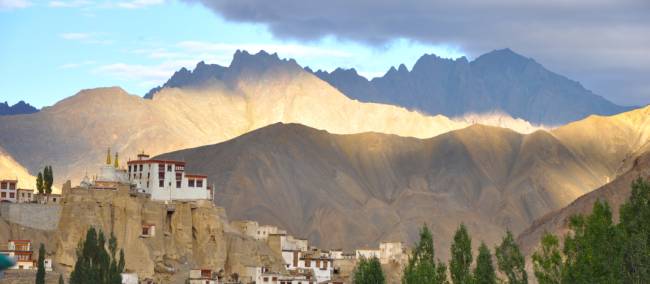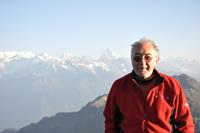
Lamayuru Monastery, Leh | Garry Weare
Blog home / Why I fell in love with the Indian Himalaya
We sat down with trekking legend and Lonely Planet author, Garry Weare, to delve into his life-long passion for the Indian Himalaya.
Garry has been involved with World Expeditions since its beginnings in the mid-1970s and is a recognised authority on the Indian Himalaya.
His intimate knowledge of the region is documented in his Lonely Planet guidebook, Trekking in the Indian Himalaya and his acclaimed narrative, A Long Walk in The Himalaya – an intriguing account of his five-month trek from the source of the Ganges to Kashmir.

Garry's infectious and enduring enthusiasm for the high mountains – particularly discovering the less-trodden paths – brings his expertise in trekking in the Himalayas to the fore. His passion may well leave you reaching for your passport.
What first drew you to the Indian Himalaya and what is it that you love most about it that keeps bringing you back?
I originally headed to India to pursue a career as a third-rate academic but decided instead to go trekking in Kashmir. After that, I spent five months trekking in Nepal, which was a profound experience that evolved into a lifetimes’ career and passion for the Himalaya. I am forever grateful that I discovered the Himalaya and embarked on a fulfilling vocation early in my working life.
 Nanda Devi sunset. Photo by Garry Weare.
Nanda Devi sunset. Photo by Garry Weare.
You must have seen great changes in the Himalaya since you first started going there in the 1970s. What do you think has changed the most? How is it different?
The extension of roads in the Himalaya has changed the culture of remote Himalayan communities. Indeed devising new treks that avoided roads was an ongoing challenge when updating my Lonely Planet guide. It reflects the adage that while trekkers want to visit remote villages, remote villagers want access to roads. Within a generation trekking in the Himalaya will more or less be restricted to National Parks.
You have walked over 25,000 kilometres on your trekking adventures; what is it that you enjoy so much about walking?
The more you return to the Himalaya you more you realise how much there is still to discover.
Every time I pore over a map I appreciate the remote valleys and seldom crossed passes that are still ripe for exploration.
The Himalaya can be a life-changing destination for those who are lucky enough to experience its sheer beauty. What is it about the Himalaya that make it so life-changing?
Inspiration in the Himalaya can come from the most humble of origins. My work with the Australian Himalayan Foundation has provided me with the opportunity to ‘put something back’ in the regions that I love and regularly return to.

What kind of cultural interactions can people expect walking along the trail?
Like villagers in most remote corners of the Himalaya, the people are forever curious as to why we have travelled halfway around the world to meet them.
For them, the sight of foreigners trekking for pleasure supported by an entourage of helpers and mule attendants contrasts with their lifestyle where they rarely travel beyond the confines of their immediate environment. Trekking through the villages provides an opportunity to revisit our values.
There's something special about visiting the isolated Hindu communities that are only visited by a handful of trekkers each year.
While I am not suggesting that a trek in the Himalaya is life-changing, the experience will undoubtedly remain for many years after returning home.
The region is one of the few places where you can still experience traditional village hospitality – a world away from teahouse trekking.
 The traditions of the two-day festival at Hemis, Ladakh.
The traditions of the two-day festival at Hemis, Ladakh.
What is the best advice you can give someone who is preparing for their first trek into the Himalaya?
Get fit, but bear in mind that a trek is not a marathon event. A sound and positive frame of mind are equally important to get over the high passes.
You are a recognised mountain photographer, what are the best tips you can give people to take stunning shots in the Himalaya?
Leave your camera in your rucksack and compose images in your mind’s eye before taking a shot. Similarly, in villages establish a rapport with the people before taking out your camera. The results will be infinitely more rewarding.
 Spectacular views from the Ganda La Pass on our Markha Valley Trek. Photo by Bruce Gray
Spectacular views from the Ganda La Pass on our Markha Valley Trek. Photo by Bruce Gray
When is the best time to visit?
Generally, the summer trekking season for the Indian Himalaya is between late June to September when exploring the high passes of Ladakh, the Markha Valley – also known as the 'Little Tibet' – or traversing the remote kingdom of Zanskar.
Read more about where and when to go trekking in the Indian Himalaya in this guide.
You're placing the region of Nanda Devi on the adventure map for trekkers. What are your favourite aspects of walking in this region?
Over the last 20 years, I have returned regularly to the Nanda Devi region. It offers a very special combination of superb mountain views and isolated village communities, along with the opportunity to follow trails leading through magnificent forests and across alpine meadows. It is indeed similar to the Annapurna region of Nepal but without the crowds.
 Trekkers in the Nanda Devi region of the Indian Himalaya. Photo by Garry Weare
Trekkers in the Nanda Devi region of the Indian Himalaya. Photo by Garry Weare
The Nanda Devi region is subject to the Indian monsoon. Both May and September are therefore ideal for gaining unsurpassed mountain views. In May, the climate is just about ideal: the long daylight hours, the rhododendrons still in bloom and the passage of the shepherds as they tend their flocks to the summer pastures make it highly attractive.
You must have met some incredible people while guiding your trips and through your work with Lonely Planet and the Australian Himalaya Foundation, yet who is it that inspired you most and why?
It’s been an honour and privilege to meet so many ‘Himalayan hands’. Not just world-class mountaineers but experts like Dr Rodney Jackson from the Snow Leopard Conservancy in California as well as lifelong friends in India and Nepal. In particular, I regularly drive to the Kangaroo Valley to catch up with Warwick Deacock, the still very active ‘grandfather’ of adventure travel. I only hope that I am still as active as he is when I turn 91.
Garry Weare – Himalayan trek guru, author and recognised authority on Indian Himalaya – regularly leads treks in this region. Find out more >